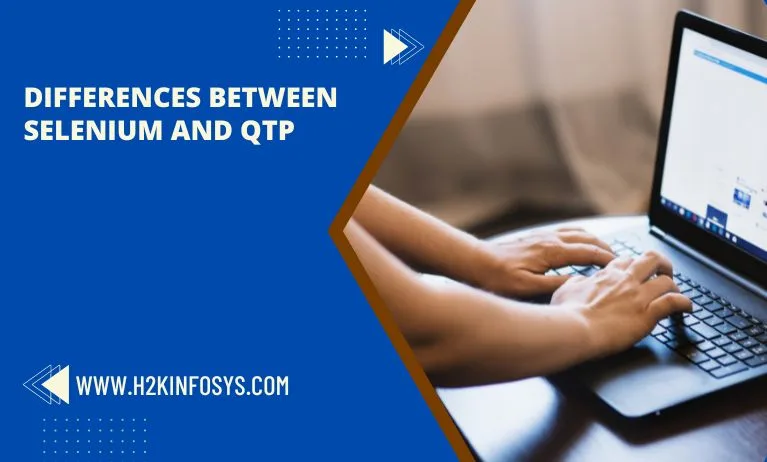Differences between Selenium and QTP

Any web-based application that is manually tested requires a significant amount of time, resources, and money. Rapid application testing cannot be accomplished solely by manual intervention. Here, automation enters the picture to minimize or completely do away with manual testing. Selenium and QTP/UFT are two regularly used tools that are available to help with the automated testing of websites.
In order to assist testers in making decisions about which tool would best serve their needs, this article compares Selenium and QTP/UFT. Check out the online Selenium certification course to learn more about Selenium.
What is Selenium?
An open-source program called Selenium automates web browsers. It offers a single interface that enables you to create test scripts in a number of different programming languages, including Ruby, Java, NodeJS, PHP, Perl, Python, and C#. After that, a browser driver on your device runs these scripts on an instance of the browser.
What is QTP/UFT?
A tool named QTP, now known as UFT, was created to carry out automatic functional testing without periodically checking the system.
Microfocus changed the name of QTP to UFT (Unified Functional Testing). Functional testing, regression testing, and service testing are the main uses of the program. UFT allows testers to automate user behaviours on a web or client-based computer program, test those actions, and find faults that may arise. This holds true for the identical activities performed by multiple users on various Windows operating systems and browsers using various data sets. If designed and carried out effectively, automation using QTP/UFT can save a significant amount of time and money.
- Several software programs and their environments can be tested using QTP/UFT.
- In addition to automating non-UI test cases like file operations, database testing, desktop apps, etc., it is used to conduct UI-based test cases.
- On the Windows operating system, QTP/UFT functions with numerous browsers, including Chrome, Firefox, and others.
- Additionally, it aids in doing QA checks on the software being tested.
- It provides simple navigation, validation of the results, and report creation.
Differences between Selenium and QTP
Software type: QTP uses a desktop application, while Selenium is utilised for a set of APIs.
Flexibility: Selenium works with every browser, but QTP exclusively supports Windows.
Licence: Selenium is licensed, whereas QTP is open-source.
Environment: QTP supports SAP and Oracle but does not include any more software add-ons, whereas Selenium permits all additional plugins.
Browser Area Accessibility: QTP manages all other website toolkits with various formats, while Selenium manages the area of the browser that is visible when the page loads.
Test Execution: While QTP needs to be integrated with Micro Focus ALM to run tests synchronously, Selenium can run tests synchronously with the integration of test frameworks like TestNG. The ALM network for QTP is for pay.
Object Repository: Selenium lacks an object repository, but QTP has one built-in from the beginning.
Performance of test execution: Selenium can be utilised in Windows or Linux virtual machines and uses minimal system resources. Windows is heavier than Linux VM. In contrast, QTP uses up more system resources. It can only be used with Windows VM, which requires more resources and upkeep.
Supported Technology: QTP supports nearly every major software application and environment, including SAP, Oracle, Salesforce, mainframes, embedded frameworks, headless browsers, and much more. Selenium has trouble automating SAP, Salesforce, and mainframe applications.
Programming language: Selenium supports advanced object-oriented programming languages like Java, but QTP only supports VBScript. As a result, QTP/UFT makes the Object-Oriented Approach to automation difficult.
The following recommendations should be reviewed before selecting one of these two tools. They highlight the key advantages of each tool over the competition.
- Only the VBScript programming language is supported by QTP/UFT. Other languages are not permitted for test scripts. But Selenium supports a huge selection of programming languages.
- Test scripts for QTP/UFT can only be run in a Windows environment. They are incompatible with all browsers. In contrast, Selenium is OS-independent and enables cross-browser testing of test scripts.
- Different IDEs are not supported by QTP/UFT. It only functions with IDEs created by QTP/UFT.
- The internal object repository of QTP/UFT aids in the organisation of application data. This feature is not offered by Selenium.
- Compared to Selenium, QTP/UFT provides automation at a faster rate.
- Both QTP/UFT and Selenium manage browser controls like the address bar, back, and advance buttons, among others.
- If a user has any problems, QTP/UFT offers enterprise support.
- Both programs create test reports automatically.
Selenium is the most widely used test automation framework, and it should be emphasised. This is due to the abundance of capabilities it provides testers looking to automate website inspection processes in addition to the fact that it is a free source. It goes without saying that testing is best done on actual devices and browsers.
conclusion
Given all of the options on the market, selecting an automation solution is not an easy task. In testing circles, the Selenium vs. QTP/UFT debate frequently comes up, and testers find themselves buried in recommendations and research to determine the best course of action. The best aspects of Selenium are covered in the online Selenium training, along with the reasons automated software testers utilise it so frequently.





